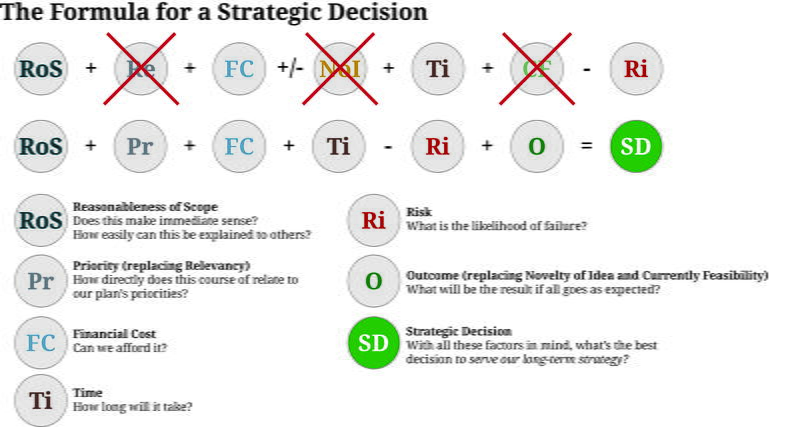
By Norman Wright
Local governments are becoming more strategic than ever before. They’ve had to. The steady increase of unfunded mandates, taxing limitations, and costs of capital have left managers and staff members with fewer resources and greater demands.
This has always been the case. One of the most timeless and inescapable truths of our work is that we can’t do everything. But it sure seems like this is more true today than ever before.
Our strategic approaches are commonly conveyed through plans that define our values and vision and often include our schedule of work for the next year. The values and vision explain why we make our choices. The schedule of work shows how we’ll carry those choices to completion.
All this material is usually created in a wonderful strategic retreat that might take a couple days or couple months to complete. From that point, many organizations formalize and systematize their plans through the budgeting process, programming the necessary money for each endeavor.
It’s all part of what has been the proven practice of corporate, military, and government bureaucracy for decades. It is classic, deliberate strategy at its finest.
Use the Exercise of Planning
Something happens, however, in the months that follow the initial strategizing. Visions and values and workplans get buried in minutia and distraction. The foundation that we built begins to crumble under the weight of more new stuff.
New development proposed on the edge of town. Rising health insurance premiums. A troubled water system. Whatever the case, there is an expression from the military that comes to mind: “No plan survives contact with the enemy.”
I think this expression rings true for all of us. We build plans, budgets, and then some new crisis du jour wallops us, coming out of nowhere to wreck our focus. Then comes the dilemma: Do we ignore the latest “emergency” and stay focused on our plan? Or do we deviate from the script and address the issue?
There is no simple answer to this question and our biggest mistake is to pretend that there should be. To that point, here is another expression, also originating from the military: “Plans are worthless, but planning is everything.”
U.S. President Dwight D. Eisenhower said this during a speech given in 1957. It was the prevailing logic behind the preparations made for exercises during World War II. The concept here is that the practice of planning fosters a certain way of thinking. Anyone can stick to their plan, doing nothing else but what’s in the plan.
Effective leaders, however, use the exercise of planning to clarify their priorities, map the broader dynamics at play, and visualize their outcomes. Planning, as a daily practice, is thus essential.
It is inevitable that an organization will veer off course from a leader’s plans. And when this happens, a leader often hangs his or her head in defeat for failing to stick to the plan, as if this “failure” were brought about by a lack of focus or discipline.
But it isn’t. Not necessarily. Because when we look at our work as a strategic practice, rather than a strategic plan, there is an important distinction that we’re able to embrace.
Two Spheres for Strategy: Deliberate and Emergent
Great strategies are formed in two fundamentally different and equally important spheres: the deliberate and the emergent. The sooner we acknowledge this and find a way to embrace it, the sooner we will get to the next level of great strategic practice. Thankfully, we’re halfway there. Deliberate strategy is one of government’s hallmarks.
Emergent strategy is a hallmark, too. We just haven’t formalized it as well as we can. Every great executive has a strategic calculator stored in his or her mind. It produces a rough calculus built on several straightforward variables. It’s a formula we use when deciding future courses of action (see Figure 1).
Figure 1 isn’t a mathematical proof, of course. And some variables matter more than others on any given day. All the same, consider this a basic attempt to find the universal method we use to make decisions on any given day. As an expression, you could describe this formula as: A good action is one that makes sense, fits the current need, is affordable, novel, timely, feasible, and won’t blow up in our faces.

This formula isn’t just ours. A similar version is used by elected officials when they sit at the dais and consider their agenda items. Their calculation is not the same, though. In fact, their method is quite mysterious!
That’s where a lot of our misunderstanding occurs. On the occasions that we use our formulas in the same way, it is quite powerful; sharing similar mental formulas is what allows us to almost read each other’s minds. Getting to that point of consistent, shared, and calculated judgment is the heart of strategic thinking. It is not strategic planning, per se.
Strategic planning is slower, more deliberate. Strategic thinking is more responsive, a higher form of reactivity. It responds to the issues and needs and opportunities that emerge from day to day—the stuff none of us could ever anticipate or plan for.
Focusing on Priorities
Consider again the old expression: No plan survives contact with the enemy.
Often, we encounter new challenges and react defensively. We raise our strategic plans up as a shield and say, “We can’t deal with that issue now! It’s not on the strategic plan!”
This is an admirable thing. It’s often the right thing to do. The strategic plan is a great tool for saying no. But the strategic plan must also be a tool for saying yes. And there’s really only one way to understand the difference: priorities.
To be a great strategic thinker, all that’s needed is to tweak the formula in Figure 1 in a few simple ways using the lens of your strategic plan; try a new version as shown in Figure 2.

This revised formula replaces relevancy with priority. Why? Because what is currently relevant (i.e., topical) is usually unimportant! The priorities of our strategic plans dictate what really matters—things like affordable housing or public safety. The more relevant topic—relevant to the daily conversation—is often minor, something like a complaint about the lighting at the new gas station. It’s a fresh issue. It’s also a minor issue according to our plan’s priorities.
The revised formula also adds outcome as a new variable. This is because we spend far too much time on any given day thinking about our risks and costs. We are hypersensitive in this way, and this natural tendency must be leavened with the thought of a return on our desired outcomes.
Yes, something costs money and staff effort, but what do we get out of it? What’s the outcome? Beginning with that desired end in mind, that outcome, is a great way to think about return on investment.
I eliminated “novelty of idea (NoI)” because we too often get fixated on new, flashy ideas. Things we call innovation are often just ideas we like for their novelty. New approaches are great but they shouldn’t be a factor in deciding our action. Innovation for the sake of innovation is not, in fact, innovation.
Finally, “current feasibility” is eliminated because we are terrible judges of what we are capable of doing. If we have the time and can afford to support something, it’s feasible. Period. Those factors are already in the equation so thinking any further on feasibility is redundant, at the least, and wrong-headed at the worst.
When we think of feasibility beyond cost and time, we usually think of it in terms of willpower or energy—as in, our own energy to do something. That is an extremely unreliable gauge.
Sticking to the Rationale
On emergent issues (i.e., the stuff that comes after the plan), discipline isn’t about sticking to a plan’s tasks, ignoring those new issues, keeping everyone rigidly on track. It’s about sticking to the rationale—the thread of logic that we used to write the plan in the first place.
We can get much better at being strategic thinkers when we formalize that logic. That’s the real discipline. That’s the real strategy.
So, to conclude, great strategy is about great rationale. You have priorities to address and outcomes to achieve. Make a plan to do this. Define the goals, values, and vision.
Those type of efforts are deliberate because they take a lot of resources. Once we commit to them, the strategic plan must reflect that commitment because we cannot deviate without enormous cost. Stick to the plan when the “enemy” puts up resistance.
But in everything else, which is almost everything you’ll face on a daily basis, stay nimble. Stick to the rationale; give yourself permission to work off-script. You’re going to anyway.
Because you have to. Strategy in the public sector is about choosing to do things that will strengthen the community while knowing you cannot do it all. It’s a difficult job. Especially when we fight against the shifting winds. A community agrees to something but then, next month, says that something else is a greater emergency. Until the next month.
Those issues usually aren’t worth a lot of time; however, sometimes they are. You have to know how to tell the difference. Embracing the deliberate and emergent, the long-term plan, and the daily practice of planning is the path to take.
Norman Wright is community development director, Salem, Oregon (norman.wright@outlook.com). Author retains the copyright to this article.
New, Reduced Membership Dues
A new, reduced dues rate is available for CAOs/ACAOs, along with additional discounts for those in smaller communities, has been implemented. Learn more and be sure to join or renew today!
